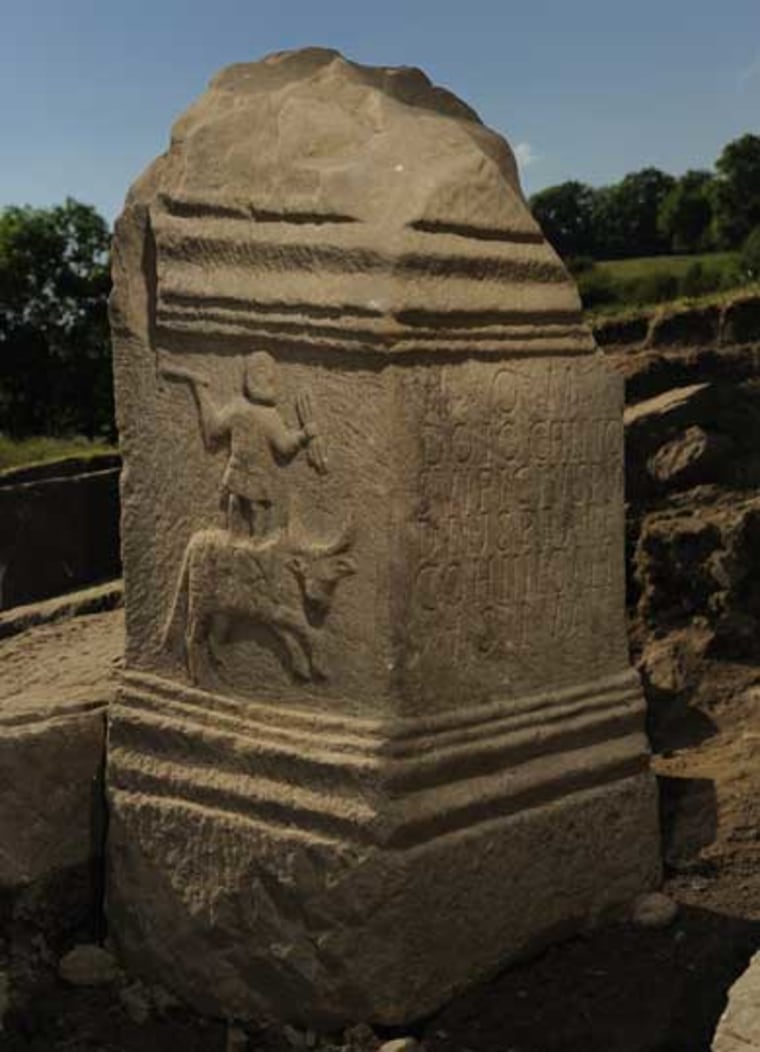A massive altar dedicated to an eastern cult deity has emerged during excavations of a Roman fort in northern England.
Weighing 1.5 tons, the four-foot high ornately carved stone relic, was unearthed at the Roman fort of Vindolanda, which was built by order of the Emperor Hadrian between 122-30 A.D.
The Romans built the defensive wall across the north of Britain from Carlisle to Newcastle-on-Tyne, to keep out invading armies from what is now Scotland.
"What should have been part of the rampart mound near to the north gate of the fort has turned out to be an amazing religious shrine," said archaeologist Andrew Birley.
A jar and a shallow dish is depicted on one side of the altar, while the other side shows a god-like figure standing on the back of a bull, with a thunderbolt in one hand and a battle axe in the other.
Romans called this god Juppiter Dolichenus, but it was originally an ancient weather god, known to the Semitic peoples of the Middle East as Hadad and to the Hittites as Teshab.
It was in its war-like representation that the Anatolian god Juppiter of Doliche became a favorite deity among Roman soldiers.
Indeed, an inscription indicates that the altar was dedicated to the Dolichenus god by "Sulpicius Pudens, prefect of the Fourth Cohort of Gauls."
Cult of Dolichenus
According to Birley, Sulpicius Pudens was the commanding officer of the Roman regiment based at Vindolanda in the third century and he may have dedicated the expensive stone to the god in thanks for fulfilling a vow.
This was a normal practice, as partial inscriptions from badly damaged Dolichenus shrines, all found in England, testify.
"The Vindolanda shrine is unique as it is situated within the walls of the fort, something which has yet to be encountered elsewhere. This casts new light on ritual spaces inside Roman forts," Birley told Discovery News.
Originally worshiped as a weather god on a hilltop close to the small town of Doliche (what is now the modern city of Duluk in southern Turkey) Juppiter of Doliche began attracting Roman worshipers by the early second century AD.
From then on, the cult of Dolichenus took off and spread all over the Roman empire.
According to Anthony Birley, chairman of the Vindolanda Trust and the author of many books on ancient Roman history, the discovery is important because "there are absolutely no literary references to Dolichenus, so all that we know about the religion is based on some 300 surviving inscriptions and sculptures from different parts of the Roman Empire."
The shrine at Vindolanda includes a small feasting room and reveals evidence of animal sacrifice.
"Since the worship of Dolichenus is not exclusively military, it is quite possible that all members of the military community, including non-combatants, may have worshiped at the shrine/temple and enjoyed the feasts held there," the archaeologist said.
Thousands of artifacts found
As for the success of the walled fort — it's uncertain how long it may have held off advancing enemies since conflicts in the rest of Europe eventually drew the Romans away from this northernmost reach of the Empire.
The altar stone is one of thousands of artifacts found from excavations at the fort and a settlement at Vindolanda.
Home to Romans from 85 A.D. until about 410 A.D., the fort has revealed the largest early archive of Latin documents (more than 1,500 documents known as "Vindolanda tablets") related to military movements.
Other finds include letters home by Roman soldiers, written in ink on wood, asking for warm clothing and socks.
While the excavation continues until mid-September, the archaeologists estimate that it could take more than a decade of work before Vindolanda reveals all of its treasures.
